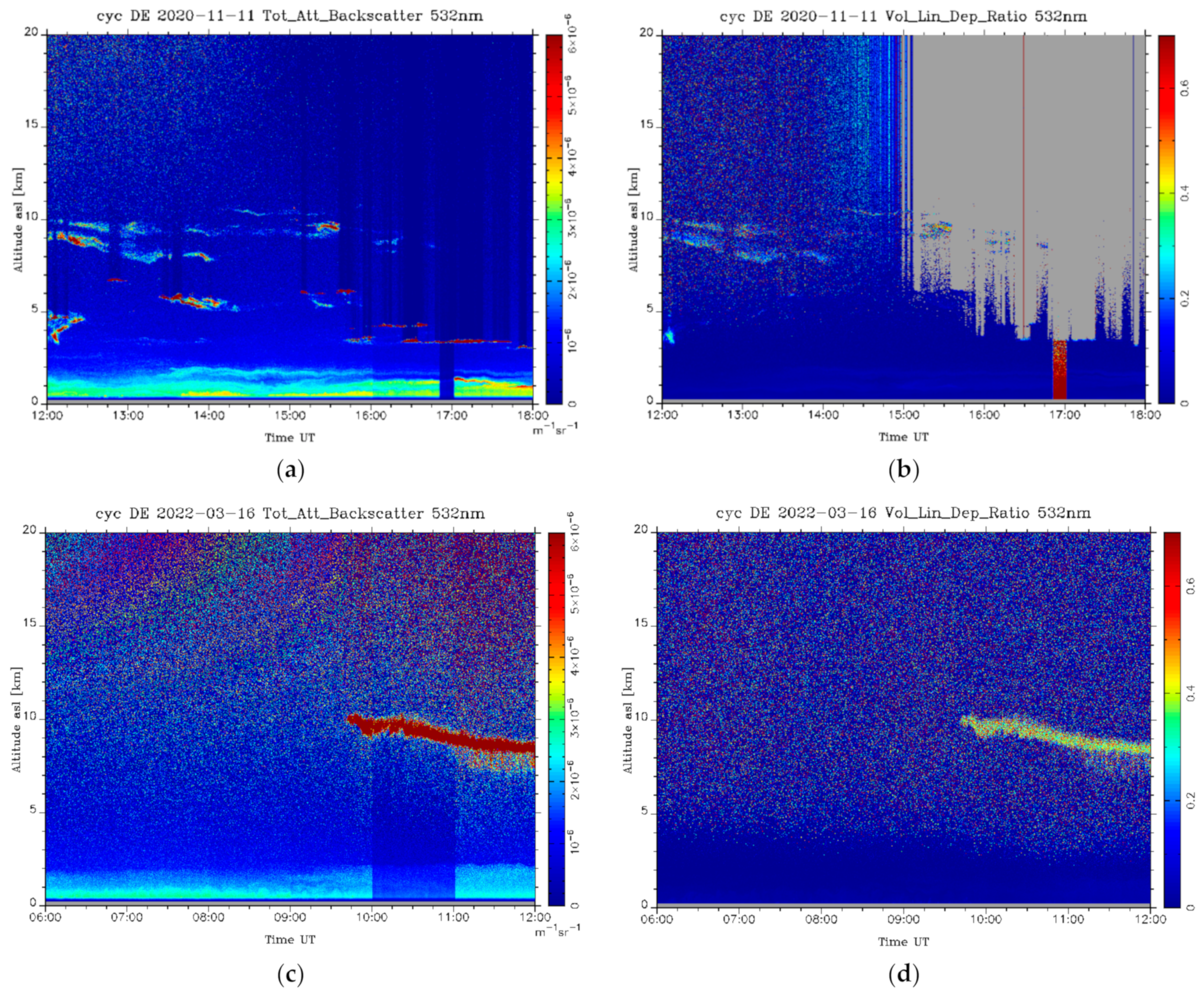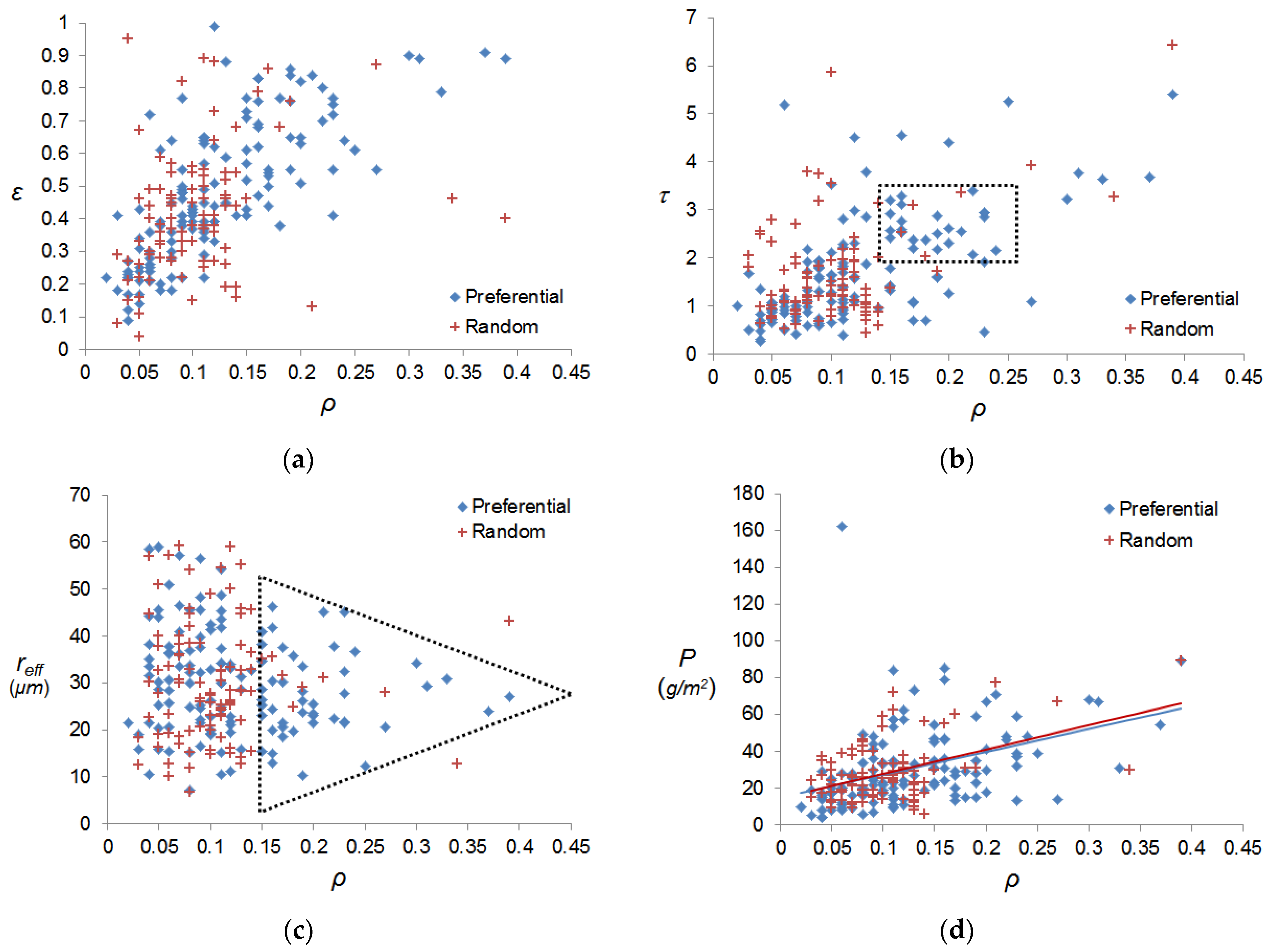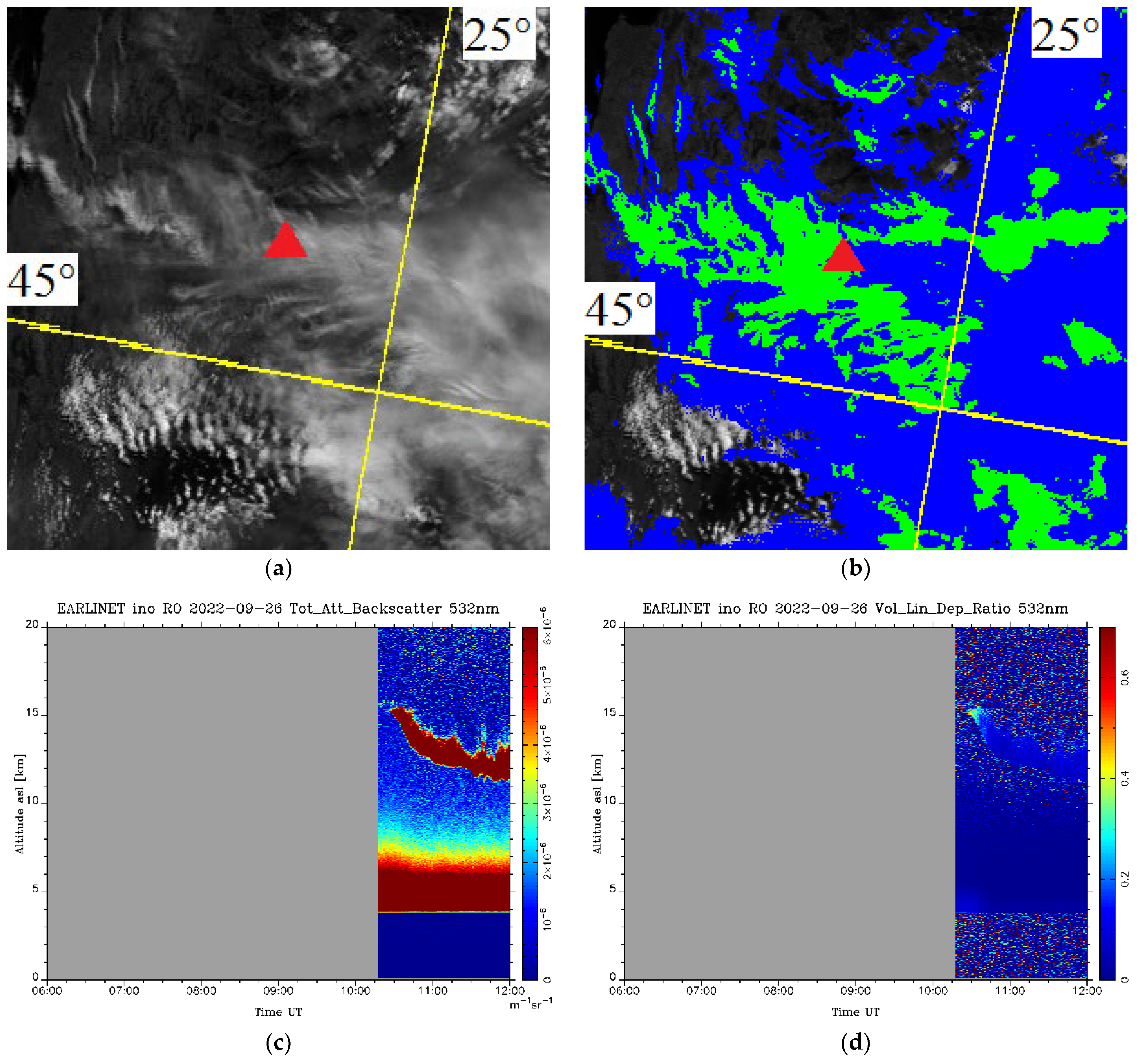Analysis of the Observation Results for Preferentially Oriented Particles in High-Level Clouds According to the EARLINET Lidar Network and MODIS Data
Abstract
1. Introduction
2. Materials
3. Method
4. Results
5. Conclusions
Author Contributions
Funding
Institutional Review Board Statement
Informed Consent Statement
Data Availability Statement
Acknowledgments
Conflicts of Interest
References
- Lynch, D.K. Cirrus clouds: Their role in climate and global change. Acta Astronaut. 1996, 38, 859–863. [Google Scholar] [CrossRef]
- Wang, M.; Penner, J.E. Cirrus clouds in a global climate model with a statistical cirrus cloud scheme. Atmos. Chem. Phys. 2010, 10, 5449–5474. [Google Scholar] [CrossRef]
- Bony, S.; Stevens, B.; Frierson, D.M.W.; Jakob, C.; Kageyama, M.; Pincus, R.; Shepherd, T.G.; Sherwood, S.C.; Siebesma, A.P.; Sobel, A.H.; et al. Clouds, circulation and climate sensitivity. Nat. Geosci. 2015, 8, 261–268. [Google Scholar] [CrossRef]
- Barja, B.; Antuña-Marrero, J.C. The effect of optically thin cirrus clouds on solar radiation in Camagüey, Cuba. Atmos. Chem. Phys. 2011, 11, 8625–8634. [Google Scholar] [CrossRef]
- Muri, H.; Kristjánsson, J.E.; Storelvmo, T.; Pfeffer, M.A. The climatic effects of modifying cirrus clouds in a climate engineering framework. J. Geophys. Res. Atmos. 2014, 119, 4174–4191. [Google Scholar] [CrossRef]
- Zhao, F.; Tang, C.; Dai, C.; Wu, X.; Wei, H. The global distribution of cirrus clouds reflectance based on MODIS Level-3 Data. Atmospere 2020, 11, 219. [Google Scholar] [CrossRef]
- Fusina, F.; Spichtinger, P.; Lohmann, U. Impact of ice supersaturated regions and thin cirrus on radiation in the midlatitudes. J. Geophys. Res. 2007, 112, D24S14. [Google Scholar] [CrossRef]
- Mitchell, D.L.; Finnegan, W. Modification of cirrus clouds to reduce global warming. Environ. Res. Lett. 2009, 4, 045102. [Google Scholar] [CrossRef]
- Fauchez, T.; Cornet, C.; Szczap, F.; Dubuisson, P.; Rosambert, T. Impact of cirrus clouds heterogeneities on top-of-atmosphere thermal infrared radiation. Atmos. Chem. Phys. 2014, 14, 5599–5615. [Google Scholar] [CrossRef]
- Matveev, J.L.; Matveev, L.T.; Soldatenko, S.A. Global Cloud Field; Gidrometeoizdat: Leningrad, Russia, 1986; pp. 180–184. [Google Scholar]
- Baum, B.A.; Yang, P.; Heymsfield, A.J.; Bansemer, A.; Cole, B.H.; Merrelli, A.; Schmitt, C.; Wang, C. Ice cloud single-scattering property models with the full phasematrix at wavelengths from 0.2 to 100 μm. J. Quant. Spectrosc. Radiat. Transf. 2014, 146, 123–139. [Google Scholar] [CrossRef]
- Konoshonkin, A.; Borovoi, A.; Kustova, N.; Okamoto, H.; Ishimoto, H.; Grynko, Y.; Förstner, J. Light scattering by ice crystals of cirrus clouds: From exact numerical methods to physical-optics approximation. J. Quant. Spectrosc. Radiat. Transf. 2017, 195, 132–140. [Google Scholar] [CrossRef]
- Stillwell, R.A.; Neely, R.R.; Thayer, J.P.; Walden, V.P.; Shupe, M.D.; Miller, N.B. Radiative influence of horizontally oriented ice crystals over summit, Greenland. J. Geophys. Res. Atmos. 2019, 124, 12141–12156. [Google Scholar] [CrossRef]
- Platt, C.M.R. Some microphysical properties of an ice cloud from lidar observation of horizontally oriented crystals. J. Appl. Meteorol. 1978, 17, 1220–1224. [Google Scholar] [CrossRef]
- Giannakaki, E.; Balis, D.S.; Amiridis, V.; Kazadzis, S. Optical and geometrical characteristics of cirrus clouds over a Southern European lidar station. Atmos. Chem. Phys. 2007, 7, 5519–5530. [Google Scholar] [CrossRef]
- Balin, Y.S.; Kaul, B.V.; Kokhanenko, G.P.; Penner, I.E. Observations of specular reflective particles and layers in crystal clouds. Opt. Express 2011, 19, 6209–6214. [Google Scholar] [CrossRef]
- Yang, P.; Liou, K.N.; Bi, L.; Liu, C.; Yi, B.; Baum, B.A. On the radiative properties of ice clouds: Light scattering, remote sensing, and radiation parameterization. Adv. Atmos. Sci. 2015, 32, 32–63. [Google Scholar] [CrossRef]
- Kaul, B.V.; Samokhvalov, I.V. Orientation of particles of Ci crystalline clouds. Part 1. Orientation at gravitational sedimentation. Opt. Atmos. I Okeana 2005, 25, 963–967. [Google Scholar]
- Sassen, K. The polarization lidar technique for cloud research: A review and current assessment. Bull. Am. Meteorol. Soc. 1991, 72, 1848–1866. [Google Scholar] [CrossRef]
- Liu, Z.; Sugimoto, N.; Murayama, T. Extinction-to-backscatter ratio of Asian dust observed with high-spectral-resolution lidar and Raman lidar. Appl. Opt. 2002, 41, 2760–2767. [Google Scholar] [CrossRef]
- Neely, R.R.; Hayman, M.; Stillwell, R.A.; Thayer, J.P.; Hardesty, R.M.; O’Neill, M.; Shupe, M.D.; Alvarez, C. Polarization lidar at summit, Greenland for the detection of cloud phase and particle orientation. J. Atmos. Ocean. Technol. 2013, 30, 1635–1655. [Google Scholar] [CrossRef]
- Ji, C.; Tao, Z.; Hu, S.; Zhang, X.; Liu, D.; Wang, Z.; Zhong, Z.; Xie, X.; Ke’e, Y.; Cao, K.; et al. Effective lidar ratio of cirrus cloud measured by three-wavelength lidar. Chin. J. Lasers 2016, 43, 0810003. [Google Scholar]
- Brown, A.J.; Videen, G.; Zubko, E.; Heavens, N.; Schlegel, N.J.; Beccera, P.; Meyer, C.; Harrison, T.; Hayne, P.; Obbard, R.; et al. The Case for a Multi-Channel Polarization Sensitive LIDAR for Investigation of Insolation-Driven Ices and Atmospheres. Planetary Science Decadal Survey White Paper; ESS Open Archive. 2020. Available online: https://essopenarchive.org/doi/full/10.1002/essoar.10503720.1 (accessed on 17 March 2023).
- Kokhanenko, G.P.; Balin, Y.S.; Klemasheva, M.G.; Nasonov, S.V.; Novoselov, M.M.; Penner, I.E.; Samoilova, S.V. Scanning polarization lidar LOSA-M3: Opportunity for research of crystalline particle orientation in the clouds of upper layers. Atmos. Meas. Tech. 2020, 13, 1113–1127. [Google Scholar] [CrossRef]
- Barlakas, V.; Geer, A.J.; Eriksson, P. Cloud Particle Orientation and Polarisation for Cross-Track Microwave Sensors in RTTOV; EUMETSAT Press: Darmstadt, Germany, 2022; pp. 1–20. [Google Scholar]
- Skorokhodov, A.V.; Nasonov, S.V.; Konoshonkin, A.V. Comparison of passive satellite data with ground-based lidar observations of specularly reflecting layers in high-level clouds. Sovrem. Probl. Distantsionnogo Zondirovaniya Zemli Iz Kosm. 2019, 16, 263–271. [Google Scholar] [CrossRef]
- Gao, B.-C.; Yang, P.; Han, W.; Li, R.-R.; Wiscombe, W.J. An algorithm using visible and 1.38-μm channels to retrieve cirrus cloud reflectances from aircraft and satellite data. IEEE Trans. Geosci. Remote Sens. 2002, 40, 1659–1668. [Google Scholar]
- Heidinger, A.; Li, Y.; Baum, B.; Holz, R.; Platnick, S.; Yang, P. Retrieval of cirrus cloud optical depth under day and night conditions from MODIS collection 6 cloud property data. Remote Sens. 2015, 7, 7257–7271. [Google Scholar] [CrossRef]
- Skorokhodov, A.V.; Konoshonkin, A.V. Comparison of satellite active and passive observations of specularly reflecting layers in the high-level clouds. Sovrem. Probl. Distantsionnogo Zondirovaniya Zemli Iz Kosm. 2021, 18, 279–287. [Google Scholar] [CrossRef]
- Bösenberg, J.; Matthias, V. EARLINET: A European Aerosol Research Lidar Network to Establish an Aerosol Climatology; MPI-Report 348; Max Planck Institute Press: Hamburg, Germany, 2003; pp. 1–200. [Google Scholar]
- EARLINET. Lidar Stations. Available online: https://www.earlinet.org/index.php?id=105 (accessed on 17 March 2023).
- LAADS DAAC. Level-1 and Atmosphere Archive & Distribution System Distributed Active Archive Center. Available online: https://ladsweb.modaps.eosdis.nasa.gov (accessed on 17 March 2023).
- Platnick, S.K.; Meyer, G.; King, M.D.; Wind, G.; Amarasinghe, N.; Marchant, B.; Arnold, G.T.; Zhang, Z.; Hubanks, P.A.; Holz, R.E.; et al. The MODIS cloud optical and microphysical products: Collection 6 updates and examples from Terra and Aqua. IEEE Trans. Geosci. Remote Sens. 2017, 55, 502–525. [Google Scholar] [CrossRef]
- Maddux, B.C.; Ackerman, S.A. Viewing geometry dependencies in MODIS cloud products. J. Atmos. Ocean. Technol. 2010, 27, 1519–1528. [Google Scholar] [CrossRef]
- Grossvenor, D.P.; Wood, R. The effect of solar zenith angle on MODIS cloud optical and microphysical retrievals within marine liquid water clouds. Atmos. Chem. Phys. 2014, 14, 7291–7321. [Google Scholar] [CrossRef]
- Zhang, D.; Wang, Z.; Kollias, P.; Vogelmann, A.M.; Yang, K.; Luo, T. Ice particle production in mid-level stratiform mixed-phase clouds observed with collocated A-Train measurements. Atmos. Chem. Phys. 2018, 18, 4317–4327. [Google Scholar] [CrossRef]
- Sassen, K.; Benson, S. A midlatitude cirrus cloud climatology from the Facility for Atmospheric Remote Sensing: II. Microphysical properties derived from lidar depolarization. J. Atmos. Sci. 2001, 58, 2103–2112. [Google Scholar] [CrossRef]




| Type of Particle Orientation | <ρ> | <ε> | <τ> | <reff>, μm | <P>, g/m2 | <hCT>, m |
|---|---|---|---|---|---|---|
| Barcelona | ||||||
| P | 0.12 | 0.45 | 1.6 | 33 | 30 | 9800 |
| R | 0.09 | 0.43 | 1.7 | 32 | 32 | 9300 |
| Leipzig | ||||||
| P | 0.14 | 0.49 | 2.0 | 29 | 35 | 10,400 |
| R | 0.10 | 0.38 | 1.8 | 30 | 29 | 10,100 |
| Lille | ||||||
| P | 0.12 | 0.44 | 2.1 | 27 | 27 | 10,400 |
| R | 0.11 | 0.40 | 1.8 | 22 | 22 | 10,900 |
| Limassol | ||||||
| P | 0.11 | 0.44 | 1.5 | 32 | 29 | 10,200 |
| R | 0.10 | 0.42 | 1.5 | 34 | 30 | 9900 |
| Évora | ||||||
| P | 0.13 | 0.50 | 1.6 | 30 | 26 | 10,000 |
| R | 0.09 | 0.48 | 1.1 | 37 | 26 | 8900 |
| All stations | ||||||
| P | 0.13 | 0.49 | 1.8 | 30 | 31 | 10,100 |
| R | 0.10 | 0.43 | 1.7 | 31 | 28 | 9900 |
Disclaimer/Publisher’s Note: The statements, opinions and data contained in all publications are solely those of the individual author(s) and contributor(s) and not of MDPI and/or the editor(s). MDPI and/or the editor(s) disclaim responsibility for any injury to people or property resulting from any ideas, methods, instructions or products referred to in the content. |
© 2023 by the authors. Licensee MDPI, Basel, Switzerland. This article is an open access article distributed under the terms and conditions of the Creative Commons Attribution (CC BY) license (https://creativecommons.org/licenses/by/4.0/).
Share and Cite
Skorokhodov, A.; Konoshonkin, A. Analysis of the Observation Results for Preferentially Oriented Particles in High-Level Clouds According to the EARLINET Lidar Network and MODIS Data. Atmosphere 2023, 14, 1018. https://doi.org/10.3390/atmos14061018
Skorokhodov A, Konoshonkin A. Analysis of the Observation Results for Preferentially Oriented Particles in High-Level Clouds According to the EARLINET Lidar Network and MODIS Data. Atmosphere. 2023; 14(6):1018. https://doi.org/10.3390/atmos14061018
Chicago/Turabian StyleSkorokhodov, Alexey, and Alexander Konoshonkin. 2023. "Analysis of the Observation Results for Preferentially Oriented Particles in High-Level Clouds According to the EARLINET Lidar Network and MODIS Data" Atmosphere 14, no. 6: 1018. https://doi.org/10.3390/atmos14061018
APA StyleSkorokhodov, A., & Konoshonkin, A. (2023). Analysis of the Observation Results for Preferentially Oriented Particles in High-Level Clouds According to the EARLINET Lidar Network and MODIS Data. Atmosphere, 14(6), 1018. https://doi.org/10.3390/atmos14061018







